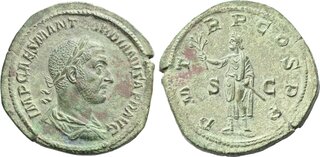| Numismatica Ars Classica > Auction 144 with CNG & NGSA | Auction date: 8 May 2024 |
| Lot number: 1140 Price realized: This lot is for sale in an upcoming auction - Bid on this lot  | Show similar lots on CoinArchives Find similar lots in upcoming auctions on |
| Lot description: The Geoffrey Cope Collection of Ancient Greek and Roman Bronzes. The Roman Empire. Gordian I, March-April 238. Description Sestertius, Roma 238, Æ 35 mm, 21.60 g. IMP CAES M ANT GORDIANVS AFR AVG Laureate, draped and cuirassed bust r. Rev. P M TR P COS P P S – C Emperor, laureate and togate, standing l., holding branch and parazonium. Reference C 3 BMC 4 RIC 7 Condition Very rare and in exceptional condition for the issue, among the finest specimens known. Struck on an exceptionally large flan with an untouched light green patina. Good extremely fine Provenance NAC sale 27, 2004, 464 Few years in Roman history were as eventful as 238, when no less than six emperors ruled. Early in the year, when the emperor Maximinus I "Thrax" was on the Danube waging war against Sarmatians and Dacians, a revolt was brewing on the distant African continent. It was led by landowners who had met their breaking point with harsh taxation they believed to be an attempt by Maximinus to punish the wealthy. The revolt sparked on March 19 or a few days afterward, and it came to be led by the proconsul of Africa, Gordian, and his eponymous son, known to history as Gordian I and II. They were among the wealthiest people in the empire, owners of unimaginably large tracts of fertile farmland in the Romanized territories of North Africa. The fact that the coinage of the Gordiani was produced in the metropolitan capitals of Rome and Alexandria, and that the Roman issues are of such excellent quality, provokes the question: did the senate merely support the Gordiani after they were made aware of the revolt, or was the uprising planned with the senatorial elite? The historical record supports the former, but the numismatic evidence might suggest the contrary. If so, it would not be the first time that coins and inscriptions contradict the poor literary sources of this period. In either case the senate backed the revolt, and its members seem to have arranged the murder of Vitalianus, the commander of the guard and a supporter of Maximinus. Clearly the nobility feared that unless the empire's elite united against the peasant soldier-emperor they would face a slow and painful annihilation. After a reign of 20 or 22 days (the ancient sources differ), the younger Gordian was killed in battle outside Carthage and the father seems to have hanged himself rather than face capture by his victorious rival Capellianus, the governor of Numidia. As is typical for the sources in this period, the accounts differ as to whether the elder Gordian committed suicide before or after his son went into battle. issues are of such excellent quality, provokes the question: did the senate merely support the Gordiani after they were made aware of the revolt, or was the uprising planned with the senatorial elite? The historical record supports the former, but the numismatic evidence might suggest the contrary. If so, it would not be the first time that coins and inscriptions contradict the poor literary sources of this period. In either case the senate backed the revolt, and its members seem to have arranged the murder of Vitalianus, the commander of the guard and a supporter of Maximinus. Clearly the nobility feared that unless the empire's elite united against the peasant soldier-emperor they would face a slow and painful annihilation. After a reign of 20 or 22 days (the ancient sources differ), the younger Gordian was killed in battle outside Carthage and the father seems to have hanged himself rather than face capture by his victorious rival Capellianus, the governor of Numidia. As is typical for the sources in this period, the accounts differ as to whether the elder Gordian committed suicide before or after his son went into battle. Estimate: 20000 CHF |  |



